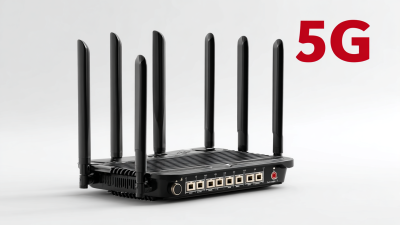In today's fast-paced digital landscape, ensuring optimal home network performance is more critical than ever. With the increasing number of connected devices—estimated to reach over 75 billion globally by 2025, according to a Statista report—the demand for robust and efficient home networking solutions is skyrocketing. One potential solution that stands out prominently is the Long Range Router, designed to cover larger areas and support more simultaneous connections without sacrificing speed. A recent study by TechRadar indicates that users of long-range routers experience up to 50% better coverage and 40% faster speeds compared to standard models. As smart homes become the norm, unlocking the secrets of these advanced routers can significantly enhance your connectivity, providing a seamless experience for everything from streaming high-definition content to playing online games.

 Long range routers are designed to extend the reach of your home network, ensuring that even the most remote corners of your house maintain a strong and reliable connection. Unlike standard routers, which may struggle to penetrate walls or cover large areas, long range routers utilize advanced antenna technology and higher power levels to broadcast signals over greater distances. This capability is particularly beneficial in larger homes or buildings with multiple floors, where dead zones can frustrate users trying to connect devices.
Long range routers are designed to extend the reach of your home network, ensuring that even the most remote corners of your house maintain a strong and reliable connection. Unlike standard routers, which may struggle to penetrate walls or cover large areas, long range routers utilize advanced antenna technology and higher power levels to broadcast signals over greater distances. This capability is particularly beneficial in larger homes or buildings with multiple floors, where dead zones can frustrate users trying to connect devices.
In addition to their impressive range capabilities, long range routers often come equipped with features that enhance overall network performance. Many models support dual-band frequencies, allowing devices to connect to either the 2.4 GHz or 5 GHz bands, which helps reduce congestion. Additionally, enhanced security protocols and quality of service (QoS) settings enable users to prioritize bandwidth for specific applications, such as gaming or streaming. This combination of extended coverage and robust performance features makes long range routers an essential upgrade for anyone looking to optimize their home network experience.
Long range routers are designed to enhance home network performance significantly, providing better coverage and faster speeds. Key features of these routers contribute to their effectiveness, making them an essential choice for households with multiple devices and users. For instance, the latest dual-band Wi-Fi 7 routers equipped with multiple 2.5G ports ensure that users can connect multiple high-speed devices simultaneously, minimizing lag and maximizing productivity.
Tips: When setting up your long-range router, consider the placement of the device. Positioning it in a central location can help maximize coverage throughout your home. Additionally, enabling Quality of Service (QoS) settings allows you to prioritize bandwidth for critical devices, ensuring smoother streaming and gaming experiences.
The advent of advanced features like beamforming technology enhances connectivity by directing signals towards connected devices, rather than broadcasting evenly in all directions. This ensures a stronger and more reliable connection, especially in larger areas. To further boost your network's performance, regularly update your router's firmware to benefit from the latest enhancements and security updates.
This chart illustrates the key performance metrics of long range routers that enhance home network performance, including signal strength, coverage area, number of devices supported, speed, and interference handling capability.
When it comes to maximizing your home network performance, the strategic positioning of your long range router is paramount. According to a recent report by the Wireless Broadband Alliance, optimal router placement can boost Wi-Fi performance by up to 40%. This is primarily due to the reduction of physical obstructions that can disrupt signal strength. The ideal location for your router is in a central area of your home, elevated off the ground, and free from interference caused by walls and electronic devices like microwaves or cordless phones.
In addition to central positioning, it's essential to consider the router's orientation and antenna direction. Research from the Institute of Electrical and Electronics Engineers reveals that angling the router's antennas vertically can enhance coverage by directing the signal horizontally and improving transmission across multiple floors. Utilizing tools like Wi-Fi analysis apps can also aid in identifying dead zones within your space, enabling you to adjust the router's placement for maximum efficacy. By following these tips, you can significantly enhance your home's Wi-Fi performance and enjoy seamless connectivity.
When enhancing your home network performance with long-range routers, avoiding common setup mistakes is crucial for maximizing efficiency. One prevalent mistake is neglecting the optimal placement of the router. According to a report by CNET, nearly 50% of users do not position their routers in central locations, which can lead to significant signal loss. Placing your router away from walls and obstructions, ideally in an elevated position, can improve signal distribution throughout your home, ensuring a strong connection in all rooms.

Another common error is failing to secure the network appropriately. A 2021 study by Norton revealed that 60% of home networks are vulnerable to external threats due to inadequate passwords and outdated firmware. Regularly updating your router’s firmware not only protects your network from security breaches but can also improve performance and efficiency. Ensuring that default usernames and passwords are changed and implementing WPA3 encryption can bolster your network’s security while enhancing overall performance. By addressing these issues, users can unlock the full potential of their long-range routers and achieve a seamless online experience.
When considering whether to upgrade your home network, it's essential to evaluate your current internet performance and the demands of your household. Long range routers can provide significant improvements, particularly if you experience weak signals or dead zones in larger homes. If multiple devices are connected simultaneously for activities like streaming, gaming, or video conferencing, an investment in a long range router can lead to a more stable and efficient connection, ensuring that everyone online has the bandwidth they need.
Another key factor is your internet usage patterns. If you have started to notice lag during peak hours or inconsistency in your connection, it may be time to upgrade. Long range routers often feature advanced technologies such as beamforming and dual-band capabilities, which optimize the signal strength and reduce interference. By investing in a long range router, you not only enhance your current network performance but also future-proof your setup, allowing for seamless connectivity as more devices enter your home network.








